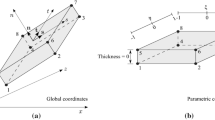Abstract
Structural engineering requires approaches allowing engineers to do simple but reliable calculations. For this purpose, we present an analytical model to evaluate the flexural strength of steel-fiber reinforced concrete sections. The model studies the compressive and tensile sectional behaviors jointly. The tensile zone of the structural element is defined through a linear stress-crack opening softening law, and it is assumed to have a planar crack (the crack surfaces remain plane during the fracture process) as a compatibility equation. The new compressive stress-strain law included in Annex L of the new Eurocode 2 for steel-fiber reinforced concrete analysis describes the compressed zone together with the Bernoulli-Navier hypothesis. A brittleness number is defined, like Hillerborg’s brittleness number for plain concrete, which depends on the size and tensile softening characteristics. The results reveal that this brittleness number influences the flexural strength of steel-fiber reinforced concrete sections. Besides, the model reproduces the size effect and its asymptotic behavior, showing the actual response in flexion of the material. Thereby, the model may be helpful to engineers in designing structural sections of steel-fiber reinforced concrete simply and reliably.
Access this chapter
Tax calculation will be finalised at checkout
Purchases are for personal use only
Similar content being viewed by others
References
Bazant Z (1984) Size effect in blunt fracture: Concrete, rock, metal. J Eng Mech 110(4):518–535
Li V, Liang E (1986) Fracture processes in concrete and fiber-reinforced cementitious composites. ASCE J Eng Mech 122(6):566–586
Shah S, Swartz S, Ouyang C (1995) Fracture mechanics of concrete: Applications of Fracture Mechanics to concrete, rock, and other quasi-brittle materials. Wiley, New York
Saucedo L, Yu R, Ruiz G (2012) Fully developed FPZ length in quasi-brittle materials. Int J Fract 178:97–112
Carpinteri A, Chiaia B, Nemati K (1997) Complex fracture energy dissipation in concrete under different loading conditions. Mech Mater 26:93–108
Pandolfi A, Conti S, Ortiz M (2006) A recursive-faulting model of distributed damage in confined brittle materials. J Mech Phys Solids 54(9):1972–2003
del Viso JR, Carmona JR, Ruiz G (2008) Shape and size effects on the compressive strength of high-strength concrete. Cem Concr Res 38(3):386–395
Carmona JR, Cortés-Buitrago R, Rey-Rey J, Ruiz G (2022) Planar crack approach to evaluate the flexural strength of fiber-reinforced concrete sections. Materials 15:5821
Carmona JR, Rey-Rey J, Ruiz G (2022) Examples of modeling of flexural behavior of fiber-reinforced concrete sections using the planar crack assumption. Hormigón y Acero 73(296):81–87
fib Bulletins 65–66, Model Code 2010, Final Draft. International Federation for Structural Concrete, fib. Lausanne, Switzerland, 2012
Ruiz G, De La Rosa Á, Wolf S, Poveda E (2019) Model for the compressive stress-strain relationship of steel fiber-reinforced concrete for non-linear structural analysis. Hormigón y Acero 69(S1):75–80
Gali S, Subramaniam K (2017) Multi-linear stress-crack separation relationships for steel fiber reinforced concrete: analytical framework and experimental evaluation. Theoret Appl Fract Mech 93(S1):33–43
Carmona JR, Ruiz G (2017) Modelo analítico para el análisis de la flexion y la fisuración en secciones de hormigón armado como alternativa al diagrama de pivotes. Hormigón y Acero 68(282):147–154
Oh B, Park D, Kim J, Choi Y (2005) Experimental and theoretical investigation on the postcracking inelastic behavior of synthetic fiber reinforced concrete beams. Cem Concr Res 35:384–392
H. Tada, H. Paris, G. Irwin, The stress analysis of cracks handbook. Professional Engineering Publishing, 1973
Hillerborg A, Modéer M, Petersson P (1976) Analysis of crack formation and crack growth in concrete by means of Fracture Mechanics and finite elements. Cem Concr Res 6(6):773–781
Planas J, Guinea G, Elices M (1995) Rupture modulus and fracture properties of concrete. In: 2nd International congress on fracture mechanics of concrete structures (FraMCoS-2), pp 95–110
Acknowledgements
The authors thank the Ministry of Science and Innovation (Spain) for financing PID2019-110928RB-C31 and RTC-2017-6736-3 projects and the Junta de Comunidades de Castilla-La Mancha (Spain) for the project SBPLY/19 /180501/000220.
Author information
Authors and Affiliations
Corresponding author
Editor information
Editors and Affiliations
Rights and permissions
Copyright information
© 2023 The Author(s), under exclusive license to Springer Nature Switzerland AG
About this paper
Cite this paper
De La Rosa, Á., Ruiz, G., Carmona, J.R. (2023). A New Model to Assess the Flexural Strength of Steel-Fiber Reinforced Concrete Sections. In: Ilki, A., Çavunt, D., Çavunt, Y.S. (eds) Building for the Future: Durable, Sustainable, Resilient. fib Symposium 2023. Lecture Notes in Civil Engineering, vol 350. Springer, Cham. https://doi.org/10.1007/978-3-031-32511-3_51
Download citation
DOI: https://doi.org/10.1007/978-3-031-32511-3_51
Published:
Publisher Name: Springer, Cham
Print ISBN: 978-3-031-32510-6
Online ISBN: 978-3-031-32511-3
eBook Packages: EngineeringEngineering (R0)




